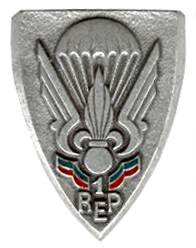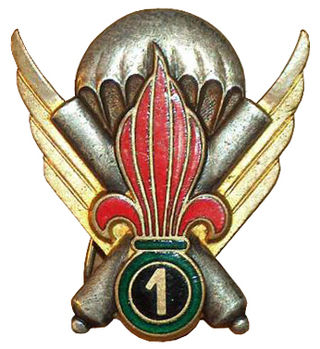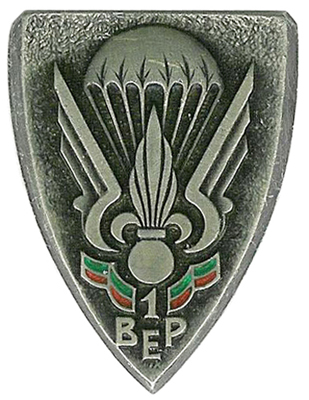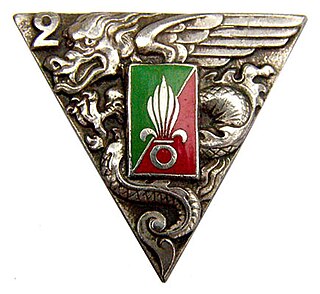
A paratrooper is a military parachutist—someone trained to parachute into a military operation, and usually functioning as part of an airborne forces. Military parachutists (troops) and parachutes were first used on a large scale during World War II for troop distribution and transportation. Paratroopers are often used in surprise attacks, to seize strategic objectives such as airfields or bridges.

Operation Castor was a French airborne operation in the First Indochina War. The operation established a fortified airhead in Điện Biên Province, in the north-west corner of Vietnam and was commanded by Brigadier General Jean Gilles. The Operation began at 10:35 on 20 November 1953, with reinforcements dropped over the following two days. With all its objectives achieved, the operation ended on 22 November. Castor was the largest airborne operation since World War II.

The 2nd Foreign Parachute Regiment is the only airborne regiment of the Foreign Legion in the French Army. It is one of the four infantry regiments of the 11th Parachute Brigade and part of the spearhead of the French rapid reaction force.

The 13th Demi-Brigade of Foreign Legion, was created in 1940 and was the main unit of the 1st Free French Division, Free French Forces (FFL). From the coast of Norway to Bir Hakeim, to Africa then the Alsace, while passing by Syria and Italy, the 13th Demi-Brigade would be part of most of the major campaigns of the French Army during the Second World War.

Pierre Charles Albert Marie Langlais was a senior French military officer who fought in World War II and the First Indochina War. Hailing from the Brittany region of France, Langlais was known as a tough and uncompromising character with an "unflagging devotion to his men."

The 1st Marine Infantry Parachute Regiment or 1er RPIMa is a unit of the French Army Special Forces Command, therefore part of the Special Operations Command.

The 3rd Marine Infantry Parachute Regiment is a one of the airborne force regiment of the Troupes de Marine. It is heir to the 3rd Colonial Commando Parachute Battalion created in 1948 and the 3rd Colonial Parachute Regiment. The regiment is part of the 11th Parachute Brigade.

The Battle of Nà Sản was fought between French Union forces and the Nationalist forces of the Việt Minh at Nà Sản, Sơn La Province, during the First Indochina War for control of the T’ai region.

The 1st Foreign Parachute Regiment was an airborne regiment of the Foreign Legion in the French Army which dated its origins to 1948. The regiment fought in the First Indochina War as the three-time reconstituted 1st Foreign Parachute Battalion, the Suez Crisis and Algerian War, but was dissolved along with the 10th Parachute Division and 25th Parachute Division following the generals' putsch against part of the French government in 1961.

Pierre Côme André Segrétain was a French infantry and airborne officer of the French Army who fought in World War II and the First Indochina War, primarily in Foreign Legion units. He received command of the 1st Foreign Parachute Battalion (1er BEP) when the battalion was created in 1948 and led for two years in Indochina before being fatally wounded while leading his battalion during the Battle of Route Coloniale 4.

The 1st Foreign Parachute Heavy Mortar Company was an ephemeral airborne forces heavy mortar of the Foreign Legion which fought during the First Indochina War at the corps of the French Far East Expeditionary Corps.

The 3rd Foreign Parachute Regiment was a parachute regiment of the Foreign Legion in the French Army and previous 3rd Foreign Parachute Battalion, from September 1, 1955, to December 1, 1955.

The 3rd Foreign Parachute Battalion was parachute battalion of the Foreign Legion formed based on the Parachute Instruction Company (C.I.P) of the 7th combat company of the 2nd Battalion of the 1st Foreign Infantry Regiment.

The 5th Vietnamese Parachute Battalion was a one of the Vietnamese National Army (VNA)'s airborne forces under the command of the Operational Group North-West (GONO), French Far East Expeditionary Corps. They were a paratrooper battalion formed in Hanoi, French Indochina in 1953.
The 1st Laotian Parachute Battalion was a paratroop battalion of the French Union Army formed in Vientiane, French Indochina in 1951. It was composed of French officers and Laotian non-commissioned officers and enlisted men, and fought in the First Indochina War.

The 1st Foreign Parachute Battalion was a parachute battalion of the Foreign Legion formed from the Parachute Company of the 3rd Foreign Infantry Regiment.

The 2nd Foreign Parachute Battalion was a parachute battalion of the Foreign Legion in the French Army initially composed of volunteers of the 4th Demi-Brigade of the Foreign Legion.

The 2nd Parachute Chasseur Regiment or 2e RCP, is one of the most decorated French units of the Second World War, the only land unit awarded the red fourragère in that war, including six citations at the orders of the armed forces. The French Navy 1500-ton class submarine Casabianca also accumulated six citations at the orders of the armed forces and therefore its crewmen were entitled to wear the same fourragère.
Pierre Georges Fernand Darmuzai was a French Général who served an entire career in the formation of the Parachute Battalions and Regiments BEPs and REPs of the Foreign Legion.














